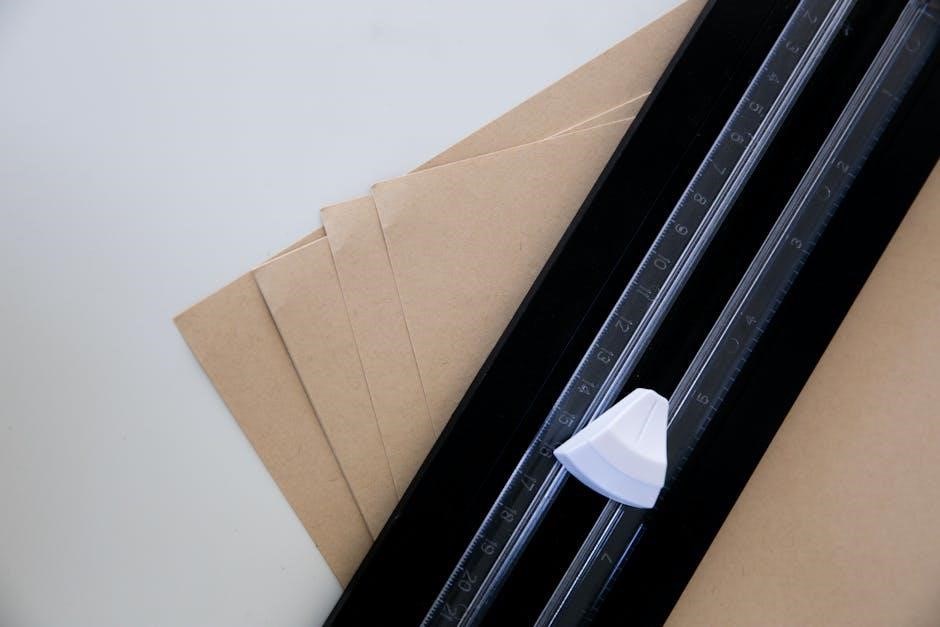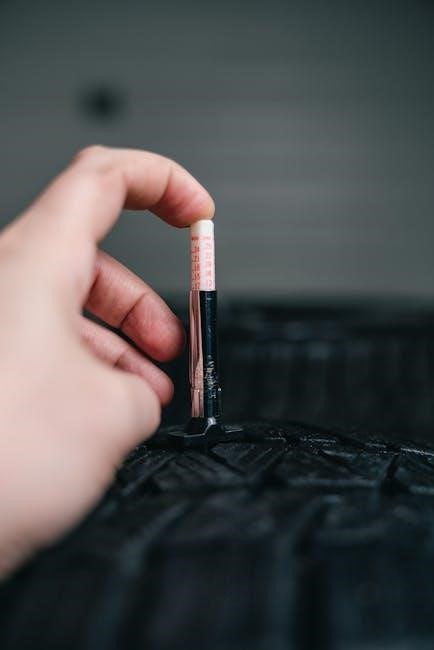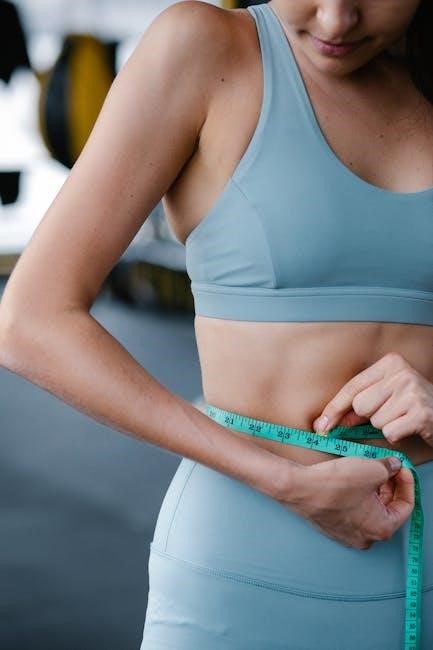
bra measurement guide
Understanding bra measurement is crucial for comfort and confidence. Many women wear incorrect sizes, leading to discomfort and health issues. This guide provides step-by-step instructions to ensure a comfortable fit and proper support.
1.1 Understanding the Basics of Bra Sizing
Bra sizing involves determining your band size and cup size. The band size is measured around your ribcage, directly under your bust, and should be snug but not tight. The cup size is calculated by subtracting your band measurement from your bust measurement. For example, if your bust measures 37 inches and your band is 34 inches, the difference of 3 inches corresponds to a cup size. Accurate sizing ensures proper support and comfort, while incorrect sizes can lead to discomfort or health issues. Understanding these basics is the first step toward finding your perfect fit and enjoying the benefits of a well-fitting bra.
1.2 The Importance of Correct Fit
A correct bra fit is essential for both comfort and health. Wearing the wrong size can lead to discomfort, poor posture, and even long-term health issues like backaches. A well-fitting bra provides proper support, enhances confidence, and improves overall appearance. Many women unknowingly wear incorrect sizes, with studies showing that 80% of women are in the wrong size. A correct fit ensures the bra stays in place, distributes weight evenly, and allows for a full range of motion. Investing time in finding your true size is a simple yet impactful step toward better health and daily comfort. Proper sizing makes a significant difference in how you feel and look.
Importance of Accurate Bra Measurement
Accurate bra measurement ensures proper support, enhances comfort, and boosts confidence. Incorrect sizes can lead to discomfort and health issues, making precise measurement essential for all women.
2.1 Health Implications of Poor Fit
Wearing a bra with a poor fit can lead to significant health issues. Back pain, poor posture, and restricted breathing are common problems caused by an ill-fitting bra. Additionally, a bra that is too tight can cause skin irritation and digging into the shoulders, leading to discomfort and potential long-term damage. Conversely, a bra that is too loose may not provide adequate support, resulting in breast strain and discomfort. Accurate bra measurement is essential to avoid these health implications and ensure proper support and comfort. Neglecting proper fit can lead to chronic issues, making it crucial to prioritize accurate sizing for overall well-being.
2.2 Enhancing Comfort and Confidence
A well-fitting bra significantly enhances comfort and confidence. Proper sizing ensures all-day ease, eliminating discomfort from tight straps or digging bands. When a bra fits correctly, it supports the breasts without restricting movement, allowing for better posture and reduced back pain. This comfort boost can improve overall confidence, as women feel more at ease in their clothing. Many report feeling more empowered and self-assured when wearing a bra that fits perfectly. Accurate measurement is key to unlocking these benefits, making it a vital step in achieving both physical and emotional well-being. A good fit can truly transform how you feel every day.

Step-by-Step Guide to Measuring Your Bra Size
Learn to measure your bra size accurately with our step-by-step guide. Ensure a snug fit by wrapping the tape around your ribcage and measuring the fullest bust part for the perfect fit.
3.1 Preparing for Measurement
Before measuring, wear a non-padded bra for accuracy. Stand in front of a mirror to ensure proper positioning. Use a soft, flexible measuring tape and keep it snug but not tight. Place the tape horizontally around your ribcage, directly under your bust, ensuring it’s level and parallel to the floor. Take a deep breath to relax your muscles, as this helps achieve a natural fit. Avoid slouching or pulling the tape too tight, as this can lead to inaccurate results. Proper preparation ensures precise measurements, making it easier to find your correct bra size and enjoy optimal comfort and support.

3.2 Tools and Tips for Accuracy
For precise measurements, use a soft, flexible measuring tape and stand in front of a mirror. Ensure the tape is snug but not tight, keeping it level and parallel to the floor. Take a deep breath to relax your muscles, as this helps achieve a natural fit. Avoid slouching or pulling the tape too tight, as this can lead to inaccurate results. Proper preparation ensures precise measurements, making it easier to find your correct bra size and enjoy optimal comfort and support.

How to Measure Your Band Size
Wrap the tape around your ribcage, directly under your bust, ensuring it’s snug and level. If the measurement is odd, round up to the nearest even number for your band size.
4.1 Positioning the Measuring Tape
Stand in front of a mirror and wrap the measuring tape around your ribcage, directly under your bust. Ensure the tape is snug and level all around your torso. Keep your posture straight and relax your shoulders. The tape should sit parallel to the floor and not slide up or down. If the tape feels too tight, it may lead to an inaccurate measurement. Take a deep breath to ensure the tape isn’t constricting. This positioning ensures you capture the correct band size, which is essential for a supportive and comfortable fit. Proper alignment is key to achieving an accurate measurement.
4.2 Ensuring a Snug and Level Fit
Achieving a snug and level fit is essential for accurate band size measurement. After positioning the tape under your bust, ensure it is neither too loose nor too tight. The tape should feel firm but comfortable, allowing for a full breath without restriction. Check that the tape is parallel to the floor and evenly aligned around your torso. If the tape rides up or sags, adjust it until it remains level. Proper alignment ensures the measurement reflects your true band size, providing a foundation for a supportive and comfortable bra fit. This step is crucial for avoiding common sizing errors and ensuring long-lasting wearability.

How to Measure Your Cup Size
Measure around the fullest part of your bust while keeping the tape level. Subtract your band size from this measurement to determine your cup size difference. This calculation ensures an accurate fit, enhancing both comfort and support. Proper cup sizing is essential for a flattering and comfortable bra fit, addressing common issues like gapping or spillage. By following these steps, you can confidently select bras that complement your shape and provide the necessary support for all-day wear. This method guarantees a precise and personalized fit, making it easier to find bras that meet your needs.
5.1 Identifying the Fullest Part of the Bust
To accurately measure your cup size, start by identifying the fullest part of your bust. This is typically the area where your bust protrudes the most, usually at nipple level. Stand in front of a mirror and position the measuring tape so it wraps around your body at this point. Ensure the tape is level and parallel to the floor, keeping it snug but not overly tight. Take a deep breath to relax your muscles, as this will help you get an accurate reading. If the tape feels restrictive, it’s too tight. Proper positioning is key to determining your correct cup size and ensuring a comfortable, supportive fit. This step is foundational for achieving the right bra size.
5;2 Calculating Cup Size Difference
Once you have your bust measurement and band size, subtract the band size from the bust measurement to determine your cup size. For example, if your bust measures 37 inches and your band size is 34 inches, the difference is 3 inches. Use a cup size chart to match this difference to your cup size. A 1-inch difference corresponds to an A cup, 2 inches to a B cup, and so on. Ensure accuracy by keeping the tape level and snug. If the difference is odd, round up to the nearest even number. This calculation ensures a precise fit, enhancing comfort and support. Proper cup sizing is essential for a flattering and comfortable bra fit. Always refer to a reliable cup size chart for accurate results.
Using a Bra Size Calculator for Accuracy
A bra size calculator simplifies the measurement process, ensuring precise results. By inputting your band and bust measurements, it calculates your exact size, saving time and guesswork for a perfect fit.
6.1 How Calculators Simplify Measurement
Bra size calculators streamline the measurement process by automating key calculations. Simply input your band and bust measurements, and the calculator determines your cup size instantly. This tool eliminates guesswork, ensuring accuracy and saving time. Many calculators also provide features like automatic rounding and size charts for reference; By reducing human error, they offer a reliable way to find your perfect fit. This makes the process easier and faster, especially for those new to measuring. With real-time results, you can confidently shop for bras that match your calculated size, enhancing comfort and support. It’s a modern solution to an often confusing task.
6.2 Interpreting Calculator Results
Once you input your measurements, the calculator provides your band size and cup size. The band size is the numerical value, while the cup size is the alphabetical difference between your bust and band measurements. For example, a 3-inch difference corresponds to a “C” cup. Use this result to shop for bras with confidence. Keep in mind that sizes may vary slightly between brands, so refer to their specific size charts. If unsure, try multiple styles to find the best fit. Regularly remeasure to ensure accuracy, as body changes can affect your size. This ensures long-term comfort and support. Accurate results empower you to make informed choices.

Common Mistakes to Avoid When Measuring
Common errors include not keeping the tape level, wearing a tight bra, and not taking deep breaths. These mistakes can lead to inaccurate measurements and discomfort.
7.1 Incorrect Band Size Measurement
One of the most common mistakes is measuring the band size incorrectly. Many women either pull the tape too tight or leave it too loose, leading to an ill-fitting bra. The tape should be snug but not restrictive, and it must remain level around the torso. Additionally, wearing a non-padded bra during measurement ensures accuracy. If the measurement results in an odd number, it should be rounded up to the nearest even number. Neglecting these steps can result in a band that is either too tight or too loose, causing discomfort and affecting the overall fit of the bra.
7.2 Misjudging Cup Size Fit
Misjudging cup size is a common issue, often leading to discomfort and poor support. Many women incorrectly measure the fullest part of their bust or fail to keep the tape level, resulting in an inaccurate cup size. The tape should be placed over the bust’s fullest point, ensuring it is not too tight or too loose. Using a bra size chart to determine the cup size difference is essential. For example, a 3-inch difference between the bust and band measurements corresponds to a specific cup size; Ignoring these steps can lead to a cup size that is either too small or too large, compromising both comfort and support.
How to Choose the Right Bra for Your Body Type
Selecting the right bra involves matching your body type with suitable styles. Petite frames may prefer minimal coverage, while fuller busts need maximum support. Consider your shape, comfort, and specific needs to find the perfect fit.
8.1 Considerations for Different Body Types
Different body types require tailored bra choices. Petite frames may opt for smaller, minimalist designs, while hourglass figures benefit from structured bras. Pear-shaped bodies may prefer bras that balance proportions, and rectangular body types can enhance curves with push-up styles. Inverted triangle body types often find T-shirt bras flattering. Understanding your body shape helps in selecting bras that complement your silhouette, ensuring both comfort and confidence. Consider factors like strap width, cup coverage, and band fit to make informed choices. The right bra can enhance your natural shape and provide optimal support, making it essential to match your body type with the appropriate style.
8.2 Matching Style to Body Shape
Matching your bra style to your body shape ensures a flattering and comfortable fit. For petite frames, opt for delicate designs with minimal coverage. Hourglass figures look stunning in structured bras that accentuate curves. Pear-shaped bodies benefit from bras with wider straps and side panels for balance. Athletic builds can choose sports bras or seamless styles for a sleek look. Inverted triangle body types find T-shirt bras ideal for a smooth silhouette. Consider your body shape when selecting bra styles to enhance your natural beauty and ensure optimal support. The right style can elevate your confidence and create a polished appearance.

The Role of Breast Shape in Bra Sizing
Breast shape significantly impacts bra fit and comfort. Common shapes include round, teardrop, and asymmetrical. Understanding your shape helps select styles that provide optimal support and aesthetics.
9.1 Understanding Breast Shape Variations
Breast shape plays a crucial role in determining the right bra fit. Common shapes include round, teardrop, and asymmetrical. Round breasts are full and equal in size, while teardrop breasts are narrower at the top and fuller at the bottom. Asymmetrical breasts differ in size or shape between the two. Understanding your breast shape helps in selecting bras that provide optimal support and comfort. For example, round breasts may benefit from full-coverage bras, while teardrop shapes might prefer molded cups. Asymmetrical breasts may require custom solutions or adjustable features. Recognizing your breast shape ensures a more personalized and flattering fit, enhancing both comfort and confidence.
9.2 Selecting Bras Based on Shape
Breast shape significantly influences bra choice. For round breasts, full-coverage or balconette bras provide balanced support. Teardrop breasts benefit from molded cups to enhance shape and separation. Asymmetrical breasts may require custom or adjustable bras for a tailored fit. Understanding your shape helps in selecting styles that flatter and support. For example, petite breasts look great in demi-cups, while fuller busts may prefer minimizers. Choosing the right style ensures comfort, confidence, and a polished appearance. Always consider your unique shape when selecting bras to achieve the best fit and support for your body.
When and Why You Should Remeasure Your Bra Size
Life changes like weight fluctuations, pregnancy, or aging can alter your bra size. Remeasure every 6-12 months to ensure a comfortable fit and proper support for your evolving body.
10.1 Life Changes Affecting Bra Size
Various life events can impact your bra size, making regular remeasurement essential. Weight fluctuations, pregnancy, and breastfeeding often lead to changes in bust size and shape. Additionally, aging can cause breast tissue to lose elasticity, affecting fit. Even hormonal changes during menopause can alter your measurements. These factors highlight the importance of reassessing your bra size periodically to ensure continued comfort and support. By staying aware of these changes, you can maintain a proper fit and enjoy the benefits of a well-fitting bra throughout different life stages.
10.2 Frequency of Remeasurement
Regular bra remeasurement is essential to maintain a proper fit. Experts recommend checking your size every 6 to 12 months, as factors like weight changes, pregnancy, or aging can alter your measurements. Additionally, significant life events, such as hormonal shifts or medical procedures, may necessitate remeasurement. Even subtle changes in body shape can affect how a bra fits, so staying proactive ensures ongoing comfort and support. By incorporating remeasurement into your routine, you can adapt to your body’s evolution and continue enjoying the benefits of a well-fitting bra throughout your life.
Benefits of Professional Bra Fittings
Professional bra fittings offer personalized expertise, ensuring a precise size and style match. Experts provide tailored recommendations, enhancing comfort, support, and confidence while addressing specific needs and preferences.
11.1 Expertise in Fit and Size
Professional fitters possess extensive knowledge of bra sizing and body types, ensuring accurate measurements. They understand how different styles and brands fit, offering tailored solutions. Their expertise helps identify the perfect band and cup size, addressing unique needs like breast shape and comfort preferences. By leveraging their experience, women can avoid common fitting mistakes and find bras that provide optimal support and a flattering silhouette. This personalized approach ensures a confident and comfortable fit, making professional fittings a valuable investment for long-term bra satisfaction.
11.2 Personalized Recommendations

Professional fitters offer tailored advice based on your unique measurements and preferences. They consider your body type, breast shape, and lifestyle to suggest styles that flatter and support. Whether you prefer wireless bras, sports bras, or lingerie, experts guide you to options that enhance comfort and confidence. Their insights help you navigate the complexities of sizing variations across brands, ensuring a perfect fit. This personalized approach not only improves your posture and appearance but also boosts your self-assurance, making it a valuable investment for long-term bra satisfaction and overall well-being.
Achieving the perfect bra fit transforms comfort, confidence, and posture. Regularly check your size and explore styles that suit your body. A well-fitting bra is an essential investment for everyday well-being.
12.1 Summary of Key Points
Accurate bra measurement is vital for comfort, health, and confidence. Measure your band size snugly around the ribcage and calculate cup size by subtracting band from bust measurements. Use tools like bra size calculators for precision and avoid common mistakes, such as incorrect positioning or tightness. Regularly reassess your size due to body changes and consider professional fittings for expert advice. Proper fit enhances posture, reduces discomfort, and boosts self-esteem. Remember, 80% of women wear the wrong size, making accurate measurement a life-enhancing process. By following these steps, you can find a bra that supports and flatters your unique shape.
12.2 Encouragement for Ongoing Fit Checks
Regularly checking your bra fit is essential for long-term comfort and confidence. Life changes, such as weight fluctuations or hormonal shifts, can alter your size. Schedule periodic self-measurements to ensure your bra continues to provide proper support. Treat it like a routine check-up—your body and confidence will thank you. By staying proactive, you can maintain a flattering fit and avoid discomfort. Remember, your bra size isn’t static, and small adjustments can make a big difference. Embrace the process as part of self-care and enjoy the benefits of a perfect fit every day.